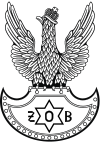Jewish Combat Organization
This article needs additional citations for verification. (August 2020) |
| Żydowska Organizacja Bojowa ייִדישע קאַמף אָרגאַניזאַציע | |
|---|---|
| Jewish Combat Organization | |
Nazi occupied Poland | |
| Engagements | World War II |
| Commanders | |
| Notable commanders | Mordechai Anielewicz Yitzhak Zuckerman Marek Edelman |
| Insignia | |
| Military eagle[dubious ] |  |
| Part of a series on the |
Underground State |
|---|
 |
The Jewish Combat Organization (
Offshoot of Jewish youth groups
The ŻOB was formed on 28 July 1942, six days after the
The youth groups that were instrumental in forming the ŻOB had anticipated German intentions to annihilate Warsaw
Unlike the older generation, the youth groups took these reports seriously and had no illusions about the true intentions of the Germans. A document published three months before the start of the deportations by Hashomer Hatzair declared: "We know that Hitler's system of murder, slaughter and robbery leads steadily to a dead end and the destruction of the Jews."[5]
A number of the left Zionist youth groups, such as Hashomer Hatzair and Dror, proposed the creation of a self-defense organization at a meeting of Warsaw Jewish leaders in March 1942. The proposal was rejected by the Jewish Labour Bund who believed that a fighting organization would fail without the help of the Polish resistance. Others rejected the notion of armed insurgency saying that there was no evidence of a threat of deportation. Moreover, they argued any armed resistance would provoke the Germans to retaliate against the whole Jewish community.[6][7]
In November 1942, ŻOB officially became part of and subordinated its activities to the High Command of the
ŻOB resistance to the second deportation
On 18 January 1943, the Nazis began a second wave of deportations. The first Jews the Germans rounded up included a number of ŻOB fighters who had intentionally crept into the column of deportees. Led by Mordechai Anielewicz they waited for the appropriate signal, then stepped out of formation, and fought the Nazis with small arms. The column scattered and news of the ŻZW and ŻOB action quickly spread throughout the ghetto. During this small deportation, the Nazis only managed to round up about 5,000 to 6,000 Jews.
The deportations lasted four days during which the Germans met other acts of resistance from the ŻOB. When they left the ghetto on 22 January 1943, the remaining Jews regarded it as a victory, however Israel Gutman, a member of the ŻOB who subsequently became one of the leading authors on Jewish Warsaw wrote, "It [was] not known [to the Jews] that the Germans had not intended to liquidate the entire ghetto by means of the January deportations." However, Gutman concludes that the "[January] deportations... had a decisive influence on the ghetto's last months."
Final deportation and uprising


All people are equal brothers;
Brown, White, Black, and Yellow.
To talk of peoples, colors, races -
Is all a made-up story!
The final deportation began on the eve of
When the Germans marched into the ghetto, they met fierce armed resistance from fighters attacking from open windows in vacated apartments. The defenders of the ghetto utilized guerrilla warfare tactics and had the strategic advantage not only of surprise but also of being able to look down on their opponents. This advantage was lost when the Germans began systematically burning all of the buildings of the ghetto forcing the fighters to leave their positions and seek cover in the underground bunkers. The fires above consumed much of the available oxygen below ground, turning the bunkers into suffocating death traps.
On May 8th in the bunder at 18 Mila Street,
By 16 May 1943, the German Police General
Epilogue
Even after the destruction of the ghetto, small numbers of Jews could still be found in the underground bunkers, on both sides of the ghetto wall. In fact, during the last months of the ghetto some 20,000 Jews fled to the Aryan side. Some Jews who escaped the final destruction of the ghetto, including youth group members and leaders Kazik Ratajzer, Zivia Lubetkin, Yitzhak Zuckerman and Marek Edelman, would participate in the 1944 Warsaw Uprising against the Nazis.
While many members and leaders of the
Similar Organizations
A second Jewish resistance organization called the
References
- ^ "Jewish Fighting Organization - Polish history". Retrieved 20 October 2018.
- ISBN 978-0300095463. Retrieved 20 October 2018 – via Google Books.
- ^ "The Warsaw Ghetto Uprising". www.ushmm.org. Retrieved 2018-05-03.
- ^ (in Polish) 23 IV 1943, Warsaw: Odezwa Żydowskiej Organizacji Bojowej z pozdrowieniami z walczącego getta i wezwaniem do walki o wspólną wolność Żydów i Polaków. Archived 2008-10-20 at the Wayback Machine Polska.pl Skarby Dziedzictwa Narodowego; Nask, 2008
- ^ Call to Armed Self-Defense, from Ha-Shomer Ha-Zair newspaper in the Warsaw Underground Jutrznia ("Dawn"), March 28, 1942.
- ^ "The Kibbutz Artzi Federation". www.jewishvirtuallibrary.org. Retrieved 20 October 2018.
- ^ Hashomer Hatzair World Movement Archived 2008-09-12 at the Wayback Machine
- ^ Korboński, Stefan. JEWS UNDER OCCUPATION. pp. 123-124 and 130. Archived from the original on 2011-09-27. Retrieved 2008-09-14.
- ^ Kochanski, Halik (2012). The Eagle Unbowed. Harvard University Press. p. 306.
- ISBN 0-03-006002-8.
- ISBN 0802224865.
Note: Chariton and Lazar were never co-authors of Wdowiński's memoir. Wdowiński is considered the single author.
External links
 Media related to Jewish Combat Organization at Wikimedia Commons
Media related to Jewish Combat Organization at Wikimedia Commons- The Warsaw Ghetto Uprising on the Yad Vashem website
